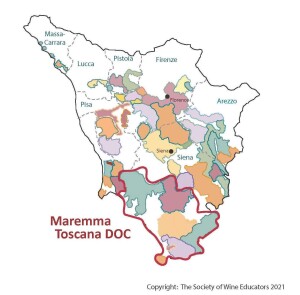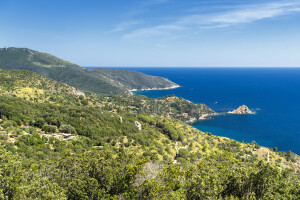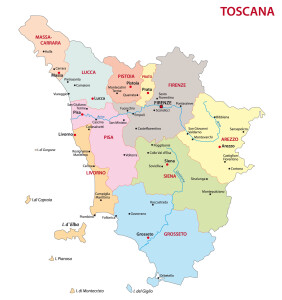 Historically, the term “Maremma” was used to indicate a large, marshy area stretching along the Italian Coast—encompassing about 100 miles/160 km of southwestern Tuscany and northern Lazio. The name Maremma is said to derive from the Spanish word marisma—meaning “marsh.” (For the geologically challenged among us, a marsh is a treeless, low-lying area that is typically water-logged, prone to flooding, and home to grasses. cattails, and reeds.)
Historically, the term “Maremma” was used to indicate a large, marshy area stretching along the Italian Coast—encompassing about 100 miles/160 km of southwestern Tuscany and northern Lazio. The name Maremma is said to derive from the Spanish word marisma—meaning “marsh.” (For the geologically challenged among us, a marsh is a treeless, low-lying area that is typically water-logged, prone to flooding, and home to grasses. cattails, and reeds.)
The area has been drained of its swampy residue several times over the course of history—most notably by order of Ferdinando I de’ Medici, Grand Duke of Tuscany, in the early 1600s—and again in the 1700s by the order of Leopold II. Modern times have seen the installation of powerful draining machines and the planting of pine forests. As a result, today’s Maremma is equally known for sandy beaches, rolling hills, wildlife preserves, and a wealth of agriculture ranging from olives and Maremma Cattle to viticulture and wine production.
The term Maremma is also used as a geographical indication for wine—as in the Maremma Toscana DOC. This Maremma Toscana DOC designation is applied specifically to the Grosseto Province, located in the southwestern corner of Tuscany. The Maremma was first established as an Indicazione Geografica Tipica (IGT) region in 1995; it was promoted to a Denominazione di Origine Controllata (DOC) in 2011.
The appellation is focused on varietally-labeled wines, including a range of typical Italian varieties (Sangiovese, Trebbiano Toscano, Ansonica) and international varieties including Cabernet Sauvignon, Chardonnay, Merlot, Sauvignon Blanc, and Syrah.
Blended wines—typically labeled simply as Rosso, Bianco or Rosato—are also produced in the region. One of the more unique styles of wine produced in the Maremma Toscana DOC is a wine labeled simply as “Cabernet” which may include any combination of Cabernet Sauvignon, Cabernet Franc, and/or Carmenère.
Advanced students of wine might be interested in the recent updates to the rules and regulations that define the wines of the Maremma Toscana DOC. In late 2020, the region’s disciplinare was revised to allow the use of two grape varieties on the label, such as Sauvignon Blanc–Viognier or Cabernet Sauvignon–Merlot. It is thought that this will make the wines more appealing to some New World markets. The standards for the use of bi-varietal labeling are as follows: the grape named first on the label must comprise 50% to 85% of the blend; and the second grape listed must comprise 15% to 50%.
- The updated regulations also include the following standards for the use of the term Riserva on the wines of the Maremma Toscana DOC:
- Red wines: minimum of 2 years of aging—to include at least six months in wood—beginning no earlier than November 1 of the harvest year
- White wines: minimum of 12 months of aging (beginning no earlier than November 1 of the harvest year)
This list of allowed wines produced in the Maremma Toscana DOC is long; and includes some wine styles typical of the region—such as dry rosso, bianco, and rosato (in varietal expressions and blends), as well as Vin Santo, sweet vendemmia tardiva (late-harvest) wines, and passito-style wines. The appellation is also one of the few in Tuscany to produce spumante (sparkling) wines. The sparkling wines of the region may be bianco or rosato and dry or extra-dry (up to 17 g/L of sugar). In addition, they may be produced via the Metodo Classico (traditional method) or the charmat method (in pressurized tank, referred to as the Metodo Martinotti).
References/for more information:
- Disciplinare di Produzione–Maremma Toscana DOC-updated 2020
- http://worldlandforms.com/landforms/marsh/
- https://brunelleschi.imss.fi.it/itineraries/itinerary/ReclamationTuscany.html
- http://www.travelingintuscany.com/engels/maremma.htm
Post authored by Jane A. Nickles…your blog administrator: jnickles@societyofwineeducators.org

